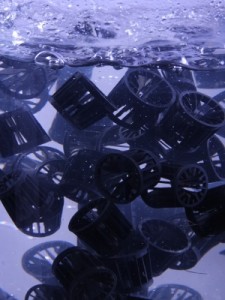MBBR Moving Bed Biofilm Reactor Technology is one of SFC Umwelttechnik GmbH´s methods for treating industrial and municipal wastewater as well as for further cleaning of already treated sewage and/or water.
General
The MBBR system consists of an aeration tank (similar to an activated sludge tank) with special plastic carriers that provide a surface where a biofilm can grow. The carriers are made of a material with a density close to the density of water (1 g/cm3). An example is high-density polyethylene (HDPE), which has a density close to 0.95 g/cm3. The carriers will be mixed in the tank by the aeration system and thus will have good contact between the substrate in the influent wastewater and the biomass on the carriers.
To prevent the plastic carriers from escaping the aeration it is necessary to have a sieve on the outlet of the tank.
Process Advantages
The MBBR system is a biofilm process. In general, biofilm processes require less space than activated sludge systems because the biomass is more concentrated and the efficiency of the system is less dependent of the final sludge separation.
- MBBR systems do not need sludge recycling like activated sludge systems.
- The MBBR system is often installed as a retrofit of existing activated sludge tanks to increase the capacity of the existing system. The amount of MBBR-carriers can be adapted to the specific situation and the desired capacity. Thus, an existing treatment plant can increase its capacity without increasing the footprint by constructing new tanks.
- When constructing, the filling degree can be set to e.g. 40% in the beginning, and later be increased to 70% by filling more carriers due to population increase in a city for a municipal wastewater treatment plant or increased wastewater production from an industrial factory.
Some other advantages compared to activated sludge systems are:
- higher effective sludge retention time (SRT), which is favourable for nitrification
- responds to load fluctuations without operator intervention
- lower sludge production
- less area required
- resilient to toxic shock
- process performance independent of secondary clarifier (because there is no sludge return line)




